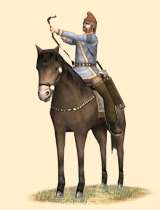Shivatîr-î Pahlavânîg (Parthian Horse-Archers)
 |
Weapons | Defence | Mental | ||||||
|---|---|---|---|---|---|---|---|---|---|
| Primary | Secondary | Armour: | 1 | Morale: | 9 | ||||
| Type: | none | sword | Shield: | 0 | Discipline: | normal | |||
| Attack: | 5 | 8 | Skill: | 9 | Training: | trained | |||
| Charge: | 12 | 12 | Recruitment | Other | |||||
| Lethality: | 1 | 0.1 | Soldiers: | 25 | Hit Points: | 1 | |||
| Range: | 187 | 0 | Cost: | 1323 | Mass: | 1 | |||
| Ammo: | 40 | 0 | Upkeep: | 331 | |||||
| Turns: | 1 | ||||||||

Light horse archers use their composite horse bows to advantage. It is their role to shower the enemy with arrows, to act as skirmishers and stay out of melee save to chase routers.
Superior
Hardy
Can Form Cantabrian Circle
These cavalrymen are recruited from the clan warriors of Parthia, and originally come from the steppes of Central Asia. Although they now live in Iran, they still learn to ride as soon as they can walk like their ancestors. They are expert archers and expert horsemen, being able to shoot a bow accurately from horseback, and they are the masters of the ‘Parthian shot’, being able to shoot backwards at full gallop. They are best used at weakening enemy formations so that the heavy cavalry can finish them off. Almost impossible to destroy and unwilling to come to grips with well ordered infantry these horsemen use marauder tactics to bring down their enemies. Dense formations of infantry are their favoured target.
Historically, the Pahlava Shivatir formed the backbone of all Parthian armies. Led by the Dehbed minor nobility into battle, these Bandaka (bondsmen or retainers) rely on missile fire as their primary asset. They used probably the best weapon for the light horseman, which was the composite horse bow. It was similar to the simple self bow but used multiple layers of wood, horn and sinew to produce a stronger bow with a greater draw weight—the force built up in the string that will propel the arrow forward to its target— for a small size.